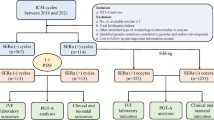Abstract
Purpose: Serum factors in patients with recurrent spontaneous abortions (RSA) inhibit mouse embryo development in vitro. Serum factors affecting DNA integrity remain to be tested. The null hypothesis was that patient sera do not affect DNA integrity. The objectives were (a) to use the oocyte comet assay to assess DNA damage after exposure to patient sera and (b) to determine the effect of sera from gravidity 0 parity 0 patients to induce DNA apoptosis.
Methods: Luteal phase sera were drawn 1 week after embryo transfer following assisted reproductive procedures. Frozen–thawed hamster zona intact oocytes at metaphase II were incubated in groups of eight in either control medium or medium supplemented with 50% patient serum for 1.5 h at 37°C in room air. The oocytes were fixed, stained in acridine orange, embedded in agarose, lysed, and alkaline electrophoresis performed. The intensities of the digitized fluorescent images were analyzed.
Results: The sera of nonpregnant patients (64%) caused significant fragmentation of hamster oocyte DNA when compared with pregnant patient sera. This difference was also observed when adjusted for patient age. Sera of patients that had never been pregnant also resulted in oocyte DNA fragmentation.
Conclusions: The results suggested that sera from patients that did not conceive contained factors that did not support cell growth by causing DNA fragmentation and apoptosis. The level of the apoptotic factors varied from cycle to cycle. However, more studies are needed to determine if the sera factors actually reach the uterine environment to cause the undesirable effects.
Similar content being viewed by others
REFERENCES
Chavez DJ, McIntyre JA: Sera from women with histories of repeated pregnancy losses cause abnormalities in peri-implantation blastocysts. J Reprod Immunol 1984;6:273-281
Oksenberg JR, Brautbar C: In vitro suppression of murine blastocysts growth by sera from women with reproductive disorders. Am J Reprod Immunol Microbiol 1986;11:118-124
Porter AJ, Singh SM, Jung JH: Evaluation of serum-associated embryotoxicity/mutagenicity in females with reproductive dysfunction using preimplantation mouse embryos in vitro. Mutagenesis 1988;3:403-408
Abir R, Zisman I, Ben HH, Yaffe P, Ornoy A: The effects of serum from women with miscarriages on the in vitro development of mouse preimplantation embryos. Acta Obstet Gynecol Scand 1990;69:27-33
Hill JA, Polgar K, Harlow BL, Anderson DJ: Evidence of embryo-and trophoblast-toxic cellular immune response(s) in women with recurrent spontaneous abortion. Am J Obstet Gynecol 1992;166:1044-1052
Dokras A, Sargent IL, Redman CWG, Barlow DH: Sera from women with unexplained infertility inhibit both mouse and human embryo growth in vitro. Fertil Steril 1993;60:285-292
Simon C, Frances A, Piquette GN, el Danasouri I, Zurawski G, Dang W, Polan ML: Embryonic implantation in mice is blocked by interleukin-1 receptor antagonist (IL-1ra). Endocrinology 1994;134:521-528
Thomason EJ, Roussev RG, Stern JJ, Coulam CB: Prevalence of embryotoxic factor in sera from women with unexplained recurrent abortion. Am J Reprod Immunol 1995;34:338-341
Fein A, Yacobovich R, Torchinsky A, Ben-Rafael Z, Carp H, Toder V: Evaluation of serum-associated embryotoxicity in women with reproductive disorders. J Assist Reprod Genet 1995;12:305-311
Cameo M, Fontana V, Cameo P, Vauthay LG, Kaplan J, Tesone M: Similar embryotoxic effects of sera from infertile patients and exogenous interferon-γ on long-term in-vitro development of mouse embryos. Hum Reprod 1999;14:959-963
Östling O, Johanson KJ: Microelectrophoretic study of radiation-induced DNA damages in individual cells. Biochem Biophys Res Commun 1984;123:291–298
Singh NP, McCoy MT, Tice RR, Schneider EL: A simple technique for quantitation of low levels of DNA damage in individual cells. Exp Cell Res 1988;175:184-191
Singh NP, Danner DB, Tice RR, McCoy MT, Collins GD, Schneider EL: Abundant alkali sensitive sites in DNA of human and mouse sperm. Exp Cell Res 1989;184:461-470
Kent CR, Eady JJ, Ross GM, Steel GG: The comet moment as a measure of DNA damage in the comet assay. Int J Radiat Biol 1995;67:655-660
Chan PJ, Calinisan JH, Corselli JU, Patton WC, King A: Updating quality control assays in the assisted reproductive technologies laboratory with a cryopreserved hamster oocyte DNA cytogenotoxic assay. J Assist Reprod Genetics 2001;18:133-138
Purdy JM: Methods for fertilization and embryo culture in vitro. In Human Conception In Vitro, RG Edwards, JM Purdy (eds), London, Academic Press, 1982, pp 135-148
Hill JA, Polgar K, Anderson DJ: T helper 1-type immunity to trophoblast in women with recurrent spontaneous abortion. J Am Med Assoc 1995;273:1933-1936
Jenkins C, Roberts J, Wilson R, MacLean MA, Shilito J, Walker JJ: Evidence of a TH 1 type response associated with recurrent miscarriage. Fertil Steril 2000;73:1206-1208
Klaude M, Ericksson S, Nygren J, Ahnström G: The comet assay: Mechanisms and technical considerations. Mutat Res 1996;363:89-96
Author information
Authors and Affiliations
Rights and permissions
About this article
Cite this article
Jebelli, B., Chan, P.J., Corselli, J. et al. Clinical Assisted Reproduction: Oocyte Comet Assay of Luteal Phase Sera from Nonpregnant Patients After Assisted Reproductive Procedures. J Assist Reprod Genet 18, 421–425 (2001). https://doi.org/10.1023/A:1016682620399
Issue Date:
DOI: https://doi.org/10.1023/A:1016682620399




